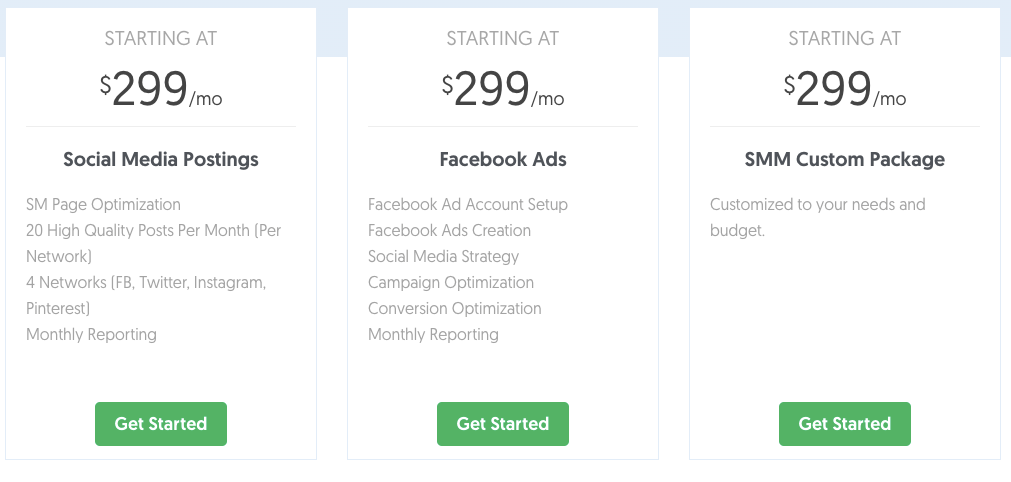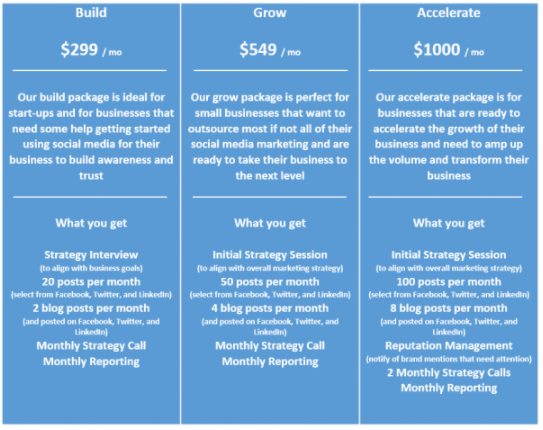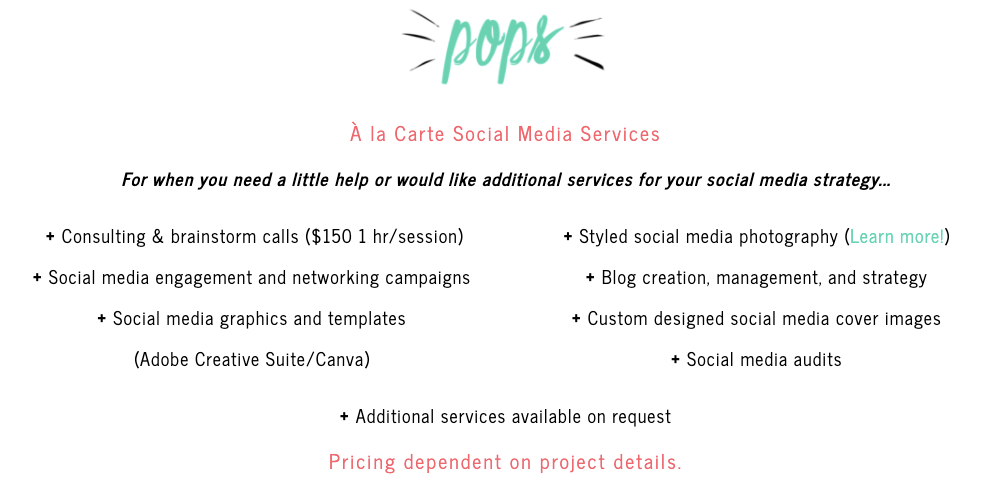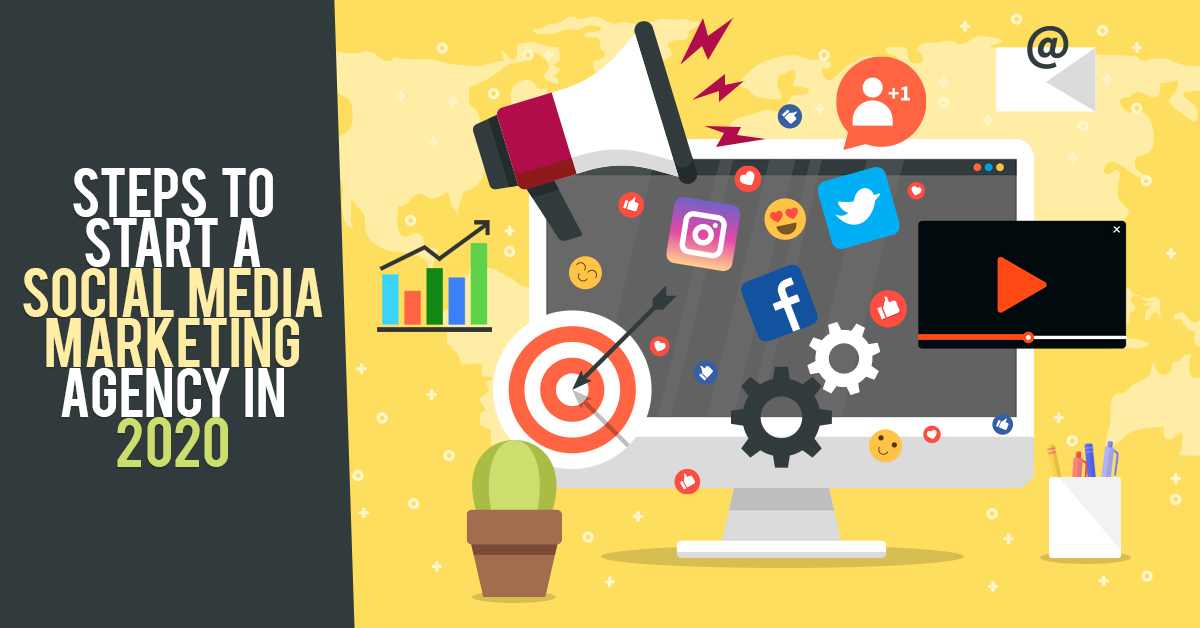Brands, small business owners, and solopreneurs can’t afford to ignore social media. So how do you start a social media marketing agency and help these brands leverage some of the most popular platforms of 2025?
Social media marketing is a fairly broad term that can mean using social media platforms to run ads for your clients, promoting your client’s brand, reaching out to new clients and audience, and/or engaging with existing customers.
And the work you’re doing is way more focused and strategic than throwing some links and pictures on your page and hoping for the best.
The same goes for starting your agency — it’s a process that takes work. You’ll need to identify a niche, hone your skills, market yourself, and more. That’s why we’re breaking it all down into 9 steps that will help you start a social media marketing agency:
- Step 1: Decide on the kind of social media marketing agency you want to start
- Step 2: Build your own social media presence
- Step 3: Grow your skills
- Step 4: Take care of the legal aspects of starting a business
- Step 5: Determine your prices and packages
- Step 6: Build a website
- Step 7: Find your first clients
- Step 8: Track your results
- Step 9: Scale your business
9 steps to start a social media marketing agency in 2025
1. Know what kind of social media marketing agency you want to start
There are two parts to this: which platforms you’ll work with and your niche. And you’ll want to start here because defining your focus in the beginning will help you with every single piece of building your agency, from growing your skills to finding clients.
Let’s talk social media platforms…
Most people who start a social media marketing agency are not working with every single platform on day 1, and some only specialize in one or two platforms as they grow their agency. Sticking to one or two platforms gives you the chance to create a focused strategy, and this is a good thing for clients.
As far as which platforms you should focus on, here are some of the top options:
- Facebook is a heavyweight with a massive audience of around 2.5 billion users worldwide, with 7 in 10 U.S. adults using the platform. Because of that reach, you can work with business owners in nearly every kind of niche.
- Instagram has a growing audience with over 1 billion active users in 2020. 80% of users follow at least one business, and 72% of users have purchased something they’ve seen on the platform. Nearly any business can use Instagram, but users skew younger. Also, Instagram is less informational than Facebook, rather more about capturing moments.
- Pinterest is part social media and part search engine. It offers versatile and affordable marketing options, and users of the platform have the highest purchase intent of any other social media platform. Over 70% of Pinterest users are female and over half of Pinterest users live outside of the U.S.
- Twitter is a powerful social networking platform that focuses on pop culture, news, industry news, etc. There are over 330 million active users, and it skews slightly more male, and 80% of users are described as affluent millennials.
- TikTok is one of the newest platforms, and it has 800 million active users. It’s mostly known for a younger user base — over 40% of users are aged 16-24 — but the rate of older users is growing.
What those numbers tell you is that there is an opportunity on every one of those platforms, but your experience and chosen niche may sway you towards one platform over another.
Read more at: How to Start a Facebook Ad Agency
Let’s talk niches…
Your niche is the kind of clients you work. Maybe it’s personal finance, fashion, fitness, health & wellness, real estate, home improvement companies, etc.
Niching down is recommended, at least when you’re learning to start a social media marketing agency, because you can get really familiar with strategies with work for that niche. For example, what works for a real estate agent isn’t going to work for a gym.
You can always expand your niche as your agency grows or start working with an entirely new niche, but keep it simple in the beginning.
But how do I decide on a niche and platform?
Great question! For niche, start thinking about what things interest you, what kind of work or personal experience you have, where you might have connections, etc. Picking something that falls under one of those umbrellas means you’ll go in with a slight advantage in the beginning.
You’ll still have a lot to learn, but you may have some practical advantages: knowing a little bit about what the audience wants, niche-specific terminology, where to find clients, etc.
Your niche can help determine your platform. Like, if you want to work in the home decor niche (bloggers, influencers, small home decor companies), Pinterest and Instagram are ideal platforms. People who focus on B2B companies can do a lot with Twitter or Facebook.
2. Build your own social media presence
Clients are going to expect their social media expert to have a social media presence. Now, they won’t expect you to have a massive following, but they want to know that you understand how the platform works and how to interact with people in that niche.
Identify industry-specific pages and groups, trending hashtags, the must-follow accounts, etc. From there, you can start sharing your own content and engaging with others in your niche.
Establishing yourself on social media shows potential clients a couple of things:
- You know how to utilize the platform in that niche
- You understand the target audience
You also get to apply what you learn to yourself. It’s like experimenting on yourself before applying things to your clients. You’re the guinea pig, so the stakes aren’t quite as high.
3. Grow your skills
Learning how to start a social media marketing agency means you know how to run ads, promote engagement, collect data, and optimize.
You can find a lot of that information for free online, but it’s a bit of a time suck to cobble together that information on your own. For that reason, here are some of the top digital marketing courses available:
- Facebook Side Hustle Course: This course teaches you how to run Facebook ads for small businesses (online and brick-and-mortar) with a strong focus on client acquisition.
- Facebook Ads for Bloggers: If you want to work specifically with bloggers and other online solopreneurs, this course covers proven strategies in that realm.
- Pinterest VA course: Learn how to run Promoted Pins along with other services you can offer clients via Pinterest.
- Twitter Flight School: This is a series of courses put out by Twitter on how to master its ads platform.
- The Complete Instagram Marketing Masterclass: A comprehensive Instagram course that helps you build relationships, optimize your client’s account, run ads, utilize Stories, and more.
- 10 TikTok Strategies That Make Me 6-Figures: For entrepreneurs, influencers, and professionals who want to start leveraging TikTok’s growing audience.
4. Take care of the legal aspects of starting a business
Running an online business has some perks — fewer start-up costs and you get to work on your own schedule, but it’s still a business. That means you need to determine your legal business structure and be set up to pay taxes.
This is probably the least exciting part of starting a social media marketing agency, but it’s important because it proves your legitimacy.
Because this is big, legal stuff, we’d rather you learn from people who know way more about this than we do, so here are a few things to check out:
- S Corp vs. LLC: LegalZoom explains the difference and why you should choose one over the other
- What Business Owners Need to Know About Taxes: Our tax attorney, Scott, joined our podcast to give expert advice
- Stay Legally Compliant: The SBA (Small Business Association) covers your legal responsibilities as a business owner
- LegalZoom Review: How to Form an LLC with LegalZoom: If you decide to structure your agency as an LLC, this article explains how to set one up
Related: Practical Guide for Creating a Digital Marketing Agency Business Plan
5. Determine your prices and packages
Back to the fun stuff…
There are a few different kinds of pricing options you can offer clients: hourly, project-based, or you can bundle different services and work on-retainer. We recommend the latter in most cases.
Packaging your services gives clients clear options for the kind of services they want, and it gives you goals and helps you manage your workload.
Here are a couple of examples of the kinds of packaged services you can offer:


You can still offer project-based and hourly pricing if you’d like, but that would be in addition to core packages. Think of those as a la carte extras, like in the example below:

The reality is that most business owners won’t know what they want until you lay it out for them. One option won’t be enough for most business owners, but limiting your services to a few options gives them the power to choose while you stay in control of the services you offer.
Stick to three packages, maybe four. Too many options can be off-putting to prospective clients.
6. Build a website
This is a must! Your website is where potential clients can see your packages and learn more about who you are — building connections is big in this business!
The good news is that building a website has never been easier, and it’s not expensive either. We recommend starting a WordPress site on Bluehost, which is only $2.95/month when you sign up through our exclusive link.
There are lots of free templates to build a beautiful site without prior technical knowledge. And this guide walks you through the process: How to Start a Blog (A Guide For Bluehost).
Yes, it says “how to start a blog,” but your blog can easily look like a business website and not have articles on it. Lots of businesses use WordPress for their sites and never publish a blog post.
Your business site should be set up with the following components:
- An “About” page that helps clients get to know who you are. Why do you love working with social media? Are you obsessed with baking, knitting, or dogs? Do you have kids? Do you love living in the mountains of Colorado? Personal information makes you stand out to clients.
- Contact information. This can be a contact form (WordPress gives you this option!) or an email address on your site.
- A picture of you. Ask a friend or partner to snap some nice pictures of you. They don’t need to be professional headshots, but they should be high-res images.
- The name of your business and logo — Canva is free graphic design software you can use to create beautiful logos and images.
- Your social handles. This one is obvious, but still worth noting: give prospective clients a way to see your work and follow you on social media.
- Services offered. Give prospective clients a clear view of your services. You don’t want to throw up a barrier by requesting that they contact you for this information — not in the beginning, at least.
One recommendation when starting your website: while it’s important, don’t get stressed about it. The reality is that lots of freelance social media marketers start finding clients before they build their sites. So don’t let this be the thing that keeps you from working.
If you’re feeling stuck, check out Launch That Blog. It’s a free service that helps you start your WordPress site. Basically, it takes care of all the technical aspects and gets you set up with all of the best plug-ins you need for your site.
7. Find your first clients
Your first few clients won’t only validate your plans to start a social media marketing agency, they also provide a valuable function — they’re going to give you some social proof.
Social proof is an important marketing concept. It’s the idea that if one or two people say your services are valuable, naturally more will follow. Testimonials and reviews are examples of social proof, and you will want to talk with your first clients about providing those things (considering they’re happy with they’re service… and you know they will be).
To find those first couple of clients, here are three recommended methods:
Look to your inner circle
Your inner circle is your friends, family, your college roommates, old coworkers, people from your book club, etc. You can use social media to tell people what you’re doing or send emails, and you leverage those connections to see if they know anyone who is interested in your services.
The small connection you share with a prospective client can make all the difference in whether or not you get hired.
Pitch clients in your niche
You’ve already read about the importance of building your social media presence, and part of that is networking with others in your niche. Identify some business owners that you’d like to work with and begin to study what they currently have in place.
Look for things that you could improve on, and then pitch those business owners with a better plan than they already have. Some of these business owners could be unhappy with their current social media manager, and some might be trying to do it all on their own.
You will definitely hear “no” a few times, but all it takes is one “yes” to get your first client.
Use online job platforms
Freelancing sites like Fiverr and UpWork are popular places for freelancers and clients to connect with one another. Depending on the platform, either freelancers list services or business owners list jobs. Professionals then shop the marketplace to find the right freelancer for their work.
It’s good because you’re surrounded by clients who are actively looking for social media managers. The downside is that you’re surrounded by other social media marketers who are also looking for clients.
These platforms also take a cut of your revenue, but think of the fact that you’re going to gain reviews or testimonials that help you grow your agency and earn more.
What should a testimonial or review look like?
Honesty is what you want more than anything. Ask your client to be genuine and share a little bit about how your social media marketing services have grown their business. They can email you a quick review or record a testimonial on their phone. Do get their permission to share their name, business name, and what they said about you.
8. Track your results
Starting a social media marketing agency means you’re in the business of helping others grow their business. This is a results-driven industry, for you and your clients.
Positive results prove that your strategy works, and this is evidence you can show to potential clients who are wondering “Will it work?”
Here are 9 different metrics you’ll want to follow and track as you start taking on clients:
- Content: This is the type of content you’re sharing — links, videos, images, etc.
- Timing: The day of the week, time of day, seasonality of posts, etc.
- Audience: What does your client’s audience look like and how does the content resonate with different facets of that audience?
- Listening: This is what people are saying about your client and their brand
- Competitor: See what others in your client’s niche are doing for ideas, where their weaknesses are, and new opportunities
- Engagement: This is how people are interacting with the content
- Traffic: How is your social media strategy driving traffic to your client’s website or business — total sessions, page views, bounce rate, etc.?
- Branding: Are you keeping up with your client’s brand and message?
- Goal and summary: Set goals for your clients and track your ability to reach those goals — pay attention to what’s worked well and what hasn’t
This article from Social Media Examiner takes a deep dive into each of these metrics and how to track them.
9. Scale your business
Some people will be content running their social media marketing agencies as a team of one — the solopreneur approach. Others will be ready to take off and hire a team of freelancers to work under them.
Neither approach is better, but the reality is that growing your team is how you’ll grow your income. So if that’s your goal, eventually you’ll need to hire some people to work with you.
The best place to start is with a virtual assistant and accountant. Your VA will help you manage your day-to-day operations like billing, answering emails, managing leads, and data entry. They don’t have to work for you full-time, but the few hours a week they do work can be a lifesaver.
An accountant handles your taxes, and this is one of the least fun parts of starting a social media marketing agency (or any business).
Outsourcing to a VA and accountant can let you spend more time focusing on your clients. Eventually, you can bring someone on your team that can be trained to do what you do. They can help you manage campaigns, especially larger ones.
Early in this article, there was something mentioned about creating a process that you can duplicate — that process will be important when you’re training people to join your team. At this point, you’ve built a system that works and generates income. A new team member can bring in some fresh ideas, but ultimately your marketing strategies are working and your clients will expect continuity and continued results.
You can train a new hire using your system, so you can keep offering the same stellar services your clients know you for.
The final word on learning how to start a social media marketing agency
9 steps… that’s a lot of work. But if you were searching for an article like this and read the entire thing, there’s a good chance you knew it wasn’t going to be easy.
It’s a hustle, but here’s what we left out about it: starting an online business like this is something you can do outside of your daily obligations. That’s the beauty of it.
You can spend an hour or two a day (put in some time before and after you go to your 9-5, after your kids go to bed, on the weekends), and grow a business that will eventually let you leave your day job.
Some days it’s hard to find the motivation to put in all of those extra hours, but think about why you’re doing this.
Do you want to leave a job you hate?
Do you want a flexible schedule that makes it easier for you to travel, spend time with your kids, see your partner?
Do you want to earn some extra cash?
The steps have all been laid out for you, so now use your reason to push you forward and get to work.


Leave a Reply